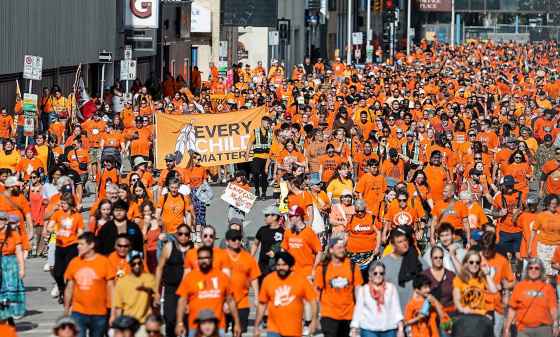FIVE STORIES ON TURTLE ISLAND
1. In the midst of the all of the attention surrounding the National Day for Truth and Reconciliation, a Leger poll stated that 38 per cent of Canadians believe Canada belongs “first and foremost” to Indigenous Peoples while 43 per cent disagree and nearly twenty per cent “didn’t know.”
The poll illustrated that the majority of those who believe Canada belongs to Indigenous peoples are younger Canadians (18-24) while nearly three-quarters of Canadians aged 65 and over disagreed or had no idea.
Another fascinating fact: of those polled, nearly fifty per cent of those born outside of Canada say Canada belongs to Indigenous peoples while one 39 per cent of Canadian-born individuals agreed.
2. The Supreme Court of Canada begins its fall session this upcoming week and will hear a fascinating case surrounding two First Nations in B.C. claiming the same land.
The conflict, between the Nisga’a Nation and the Gitanyow Nation, is most interesting because the Nisga’a signed a landmark treaty in the year 2000 which the Gitanyow claim involved lands that come under their rights and title.
This creates one of those weird “made-in-Canada” situations where Canadian courts — which have recognized Indigenous law exists and is outside of Canadian jurisdiction — have to make a decision that impacts Indigenous rights and title. Add in this conflict and the decision is basically a verdict on the integrity of the modern treaty process in B.C. and this one is worth watching.
3. New research out of the University of Ottawa has revealed that more than one-third of Canadians present symptoms of depression and anxiety, with Indigenous, racialized and younger populations experiencing the majority of cases.
Surveying more than 4000 Canadians across racial groups, the study showed that depressive symptoms was highest among Indigenous participants (49.37 per cent), followed by people of Arab (44.23 per cent), Asian (41.42 per cent), Black (32.92 per cent), and white (32.69 per cent) descent.
Younger participants consistently reported higher depressive and severe depressive symptoms with 54.1 per cent of Indigenous young women at the top of that list. The prevalence of anxiety was highest among Indigenous peoples (47.58 per cent) as well.
Women were 1.47 times more likely to report anxiety symptoms than men, and non-binary individuals were at an even higher risk.
4. The Good Canadian is a new documentary featured on CBC platforms which documents the ongoing struggles of Indigenous peoples in Canada and how systemic racism, chronic neglect and underfunding, and misunderstanding leads to many of this country’s worst outcomes.
A few of the sobering statistics based on the 2021 census: 23.7 per cent of Indigenous children were living in poverty compared to 10.8 per cent of non-Indigenous children; life expectancy for Indigenous people is 77 years compared to 85 years for non-Indigenous people; and eight per cent of children in Canada are Indigenous but they make up 54 per cent of those in foster care.
Featuring voices of Indigenous leaders such as Cindy Blackstock, and directed by Leena Minifie and David Paperny, The Good Canadian is proof that violence isn’t something only happening overseas but right in our backyard.
5. Sept. 30 is also a special day for Indigenous peoples in the United States. Called “The National Day of Remembrance for U.S. Indian Boarding Schools” the day honors the lives of Native American children who, in the 1800s to the mid 20th century, were taken from away from their families and put into assimilative schools with often dangerous conditions. Many never returned home. The U.S.-based day also includes the wearing of orange shirts and shares many similar stories and legacies with Canadian residential schools.
IN PICTURES

People take part in the Orange Shirt Healing Walk and Powwow in Winnipeg Tuesday. (John Woods / Free Press)
For a full photo gallery of scenes from this year’s National Day of Truth and Reconciliation in Winnipeg, click here.
RECONCILI-ACTION OF THE WEEK
Every week I highlight an action, moment, or milestone forwarding reconciliation, illustrating how far Canada has come — and how far the country has yet to go.
This week’s reconciliaction of the week is for all of my Free Press colleagues — whose coverage once again documented the National Day for Truth and Reconciliation with grace, sensitivity, and showcased the complicated nature of the day.
Getting interviews, photos, and information on such a hard day for many Indigenous peoples (not to mention a holiday) is impressive and our paper once again showed why we are leaders on the documenting the process of truth and reconciliation in Canada.
There was of course these incredible series of photos by the talented John Woods, and this detailed piece on the day in Winnipeg by my colleague Malak Abas, a great and brilliant column written to children by the returning Melissa Martin, and great coverage by Scott Billeck on the new installations at the former site of the Assiniboia Residential School. There is, of course, our usual fare of Indigenous-centred stories, like this one on Indigenous language use in Manitoba Schools by Maggie Macintosh or this one on the wrongly convicted Russell Woodhouse by Dan Lett, but they hit a little different on the National Day.
Of course, there’s also this week’s launch of season 4 of the Niigaan and the Lone Ranger podcast featuring an interview with Premier Wab Kinew, who tells an incredible story of visiting young Indigenous men in prisons and how that has impacted his work and perspective.
I could go on and talk about so many others who work at the paper but this all goes to say how proud I am working at the Free Press and how dynamic and dedicated to the issue of truth and reconciliation this little independent newspaper is.
|

